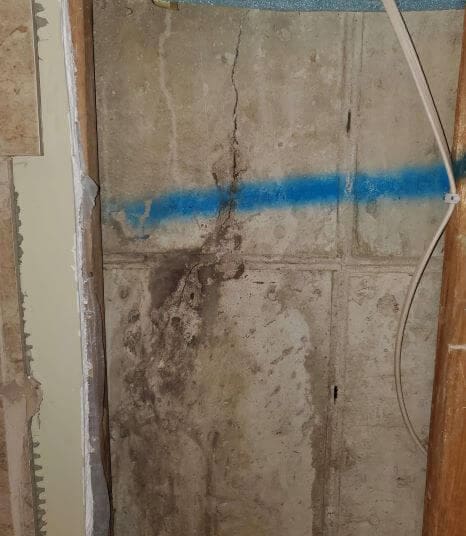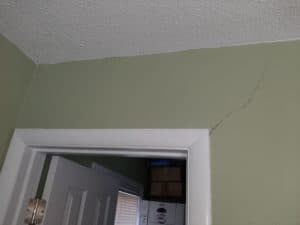Why Are Your Walls Cracking?

Originally posted 2/11/19; updated 6/30/21
When you hear “signs of foundation damage,” you probably think about cracks in your foundation, right? This is certainly a logical connection to make. But there are warning signs of foundation damage in other places, too. This is because problems in your foundation don’t stay in your foundation; they spread out into the rest of your home.
Acculevel is a family-owned and operated company that specializes in waterproofing and foundation repairs. We want to help people preserve and protect their greatest investments, restoring health and stability to their homes. Since our start in 1996, we’ve helped over 30,000 homeowners in Indiana and the surrounding areas.
We want to help you recognize warning signs of damage, as soon as they appear. When foundation damage is diagnosed earlier in its development, the repairs are easier to make and are less expensive. So in this article, we’re going to explain how and why cracks appear, while providing resources to help you learn about repair methods and estimate costs.
Reasons Why Your Walls May Crack
There are two major reasons why cracks form in your home’s walls: settling and hydrostatic pressure.
How Foundations Settle
Erosion is the primary reason a home’s foundation settles. As water makes its way through the soil, the dirt moves. If the soil moves away from the foundation, or creates a gap under the foundation, settling occurs. This shifting is made worse by the freezing and thawing cycles we experience in Midwestern winters, because water in the soil expands and contracts with the temperature changes.
Settling isn’t automatically an issue; homes settle when they’re first built. But when a new home settles, it usually does so at a uniform speed- it’s the weight of the house sinking into the ground.
Erosion, on the other hand, does not equally affect all four sides of your home. It’s usually worse in one section, and that is what creates settling damage. Your foundation isn’t designed to flex or move- in fact, none of the components in your home are. Wooden beams, concrete, and drywall are all meant to stay in place. When the foundation shifts towards one corner, it pulls at the rest of the foundation. Since the concrete can’t stretch, it cracks.
 This photo was taken by an Acculevel project manager during a free estimate appointment. The foundation of this garage is shifting towards one corner, causing an extensive crack to form.
This photo was taken by an Acculevel project manager during a free estimate appointment. The foundation of this garage is shifting towards one corner, causing an extensive crack to form.
Signs Your Foundation Is Settling
As your foundation strains against the settling section, it also strains the house attached to it. Just like concrete, drywall and wood framing also struggle with being inflexible materials. You should keep an eye out for the following:
- Cracks in the house in your drywall, especially around doors or windows.
- Cracks outside the house, in the foundation. They will look like the one in the photo above, although hopefully they won’t be that significant when you spot them!
- Windows or doors that are difficult to open or close. Sometimes referred to as “sticking,” you’re looking for doors or windows that don’t move smoothly in their frames. If you’ve found drywall cracks near an entryway, you should test the door/window. These two symptoms usually go together.
 This photo was taken by an Acculevel project manager during a free estimate appointment. The door does not stay closed unless locked, and there’s a crack in the drywall.
This photo was taken by an Acculevel project manager during a free estimate appointment. The door does not stay closed unless locked, and there’s a crack in the drywall.
If your foundation is settling, you will need helical piers to fix it. The primary purpose of piers is to stabilize the foundation, and prevent it from settling any further. You can learn more about helical piers and repair costs here.
How Hydrostatic Pressure Causes Cracks
Hydrostatic pressure is what happens when there is more water in the ground than the soil can absorb. This excessive water presses against anything in its path, trying to make its way through. Sometimes, it ends up pressing against your foundation- which is not built to function as a dam.
Foundations are usually made of concrete, which is a porous material. If enough water gathers, it gradually seeps into your foundation and leaks through. Over time, it makes a sort of path for itself, weakening the foundation and creating cracks.
 This photo was taken by an Acculevel project manager during a free estimate appointment. You can see a long vertical crack in the wall.
This photo was taken by an Acculevel project manager during a free estimate appointment. You can see a long vertical crack in the wall.
Sometimes these cracks are vertical, and in those cases, water intrusion is your biggest concern. In the photo above, the homeowner only discovered the crack after the drywall and carpet got wet. This is common in a finished basement, since the foundation itself is covered from view.
If you don’t currently have a finished basement, but are thinking about making that type of renovation, we strongly recommend encapsulation. This is the ideal way to prevent water damage to your drywall, flooring, and other finishes.
Signs of Hydrostatic Pressure
Vertical cracks and water damage are significant concerns for any homeowner. But if the crack is horizontal or an interior stair-step, you need to get a professional assessment as soon as possible.
 This photo was taken by an Acculevel project manager during a free estimate appointment.
This photo was taken by an Acculevel project manager during a free estimate appointment.
Both long horizontal and interior stair-step cracks indicate the same thing: hydrostatic pressure is pushing your wall inward. (If your home has a poured concrete wall, you’re not going to see a stair-step, only the horizontal break.)
You do not want your basement wall bowing, and you absolutely do not want it falling in. A collapsing foundation wall renders your entire home unstable. As the “lean” of the wall becomes more significant, repair methods become more expensive, so it is important to take action when the issue is still small. We explore the different types of bowing wall repairs here.
Have You Noticed Signs of Foundation Trouble in Your Home?
If there are other indications that something is wrong with your home, please take advantage of our Symptom Checker. This is a free tool we’ve designed for homeowners to use, to help them learn about foundation issues. Simply select the symptom or issue that you’re experiencing, and the system will generate an explanation, along with additional materials for you to read or watch. We believe the best customer is a well-informed one, and want you to have all the information you need to decide what’s best for you and your home.
If You Need a Free Assessment of Your Foundation Issues
Do you live in Indiana or the surrounding areas? If so, call Acculevel! We will schedule an appointment for you, with one of our knowledgeable and experienced project managers. They will meet you on time, discuss your concerns, and evaluate your home. Once a full assessment is done, they’ll provide you with a written estimate for any necessary repairs. We want to help you keep your home healthy and strong, by developing solutions that address your entire home.

